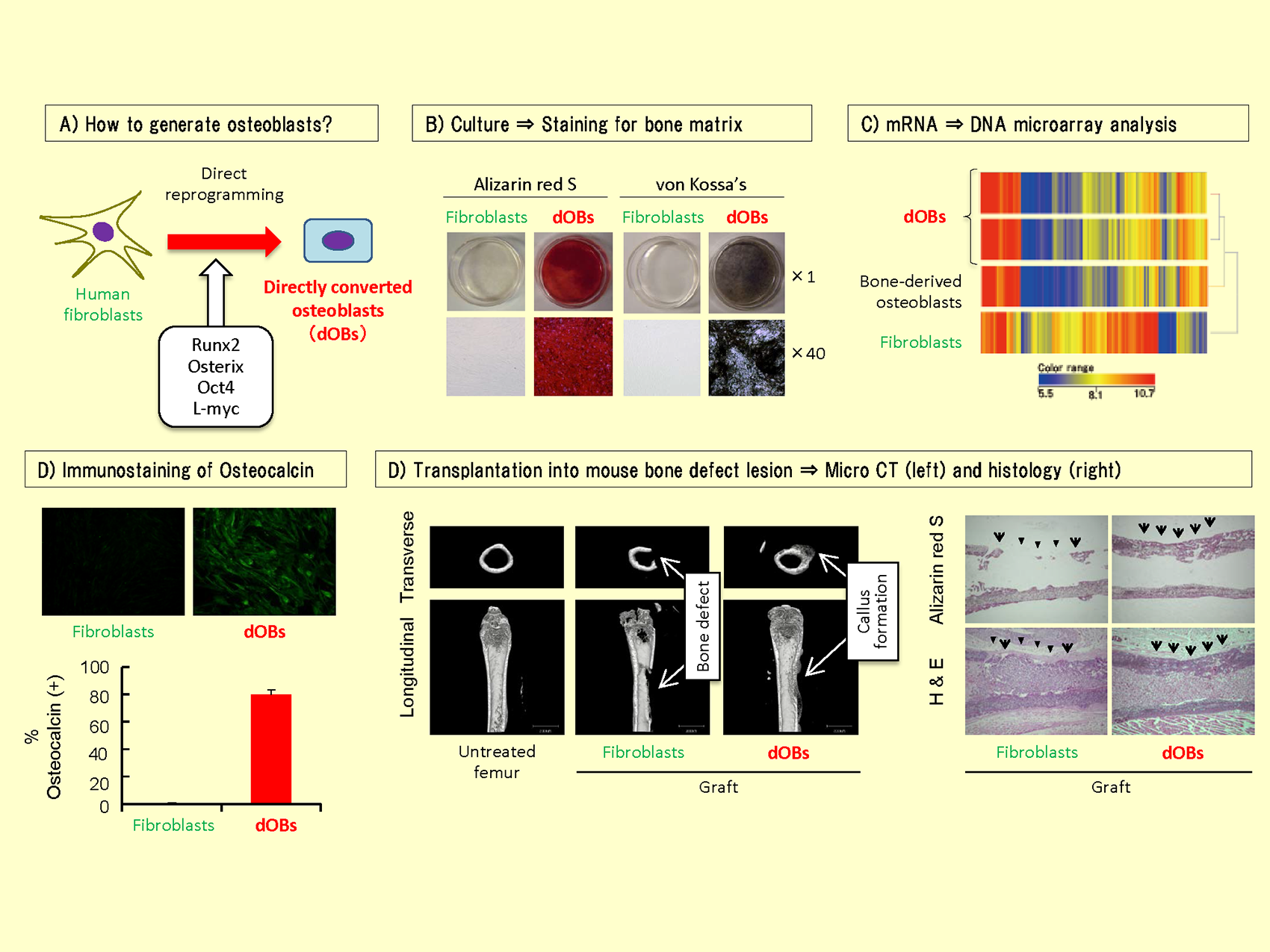プロジェクトのご紹介 9 - Project 9 -
骨芽細胞のダイレクト・リプログラミングと骨再生
Direct reprogramming of functional osteoblasts that regenerate bone tissue

高齢化が急速に進む中、骨折後の癒合不全や偽関節などで、障害や長期臥床に陥る高齢者が増加している。骨芽細胞は石灰化骨基質を産生し骨の形成とリモデリングに寄与する主要な細胞である。
我々は、ヒトの線維芽細胞にRunx2, Osterix, Oct4 and L-myc(RXOL)の4因子の遺伝子を導入することで、機能的な骨芽細胞を直接誘導する技術を樹立した。その効率は80%以上であり、得られた骨芽細胞(dOB)は骨芽細胞特異的マーカーを発現し、石灰化骨基質を多量に産生し、ヒト骨由来骨芽細胞に類似の遺伝子発現を示した。マウスの骨欠損部にdOBを移植すると、骨基質を産生して骨再生に寄与した。本研究は新しい骨再生治療に発展する可能性が期待できる(山本他、Proc Natl Acad Sci USA)。
In the rapidly aging society, a growing number of elderlies suffer from disability or immobility due to non-union or false joints of fractured bone lesions. Osteoblasts essentially contribute to bone formation and remodelling by producing and calcifying the bone matrix. We succeeded in reprogramming human fibroblasts into functional osteoblasts by transducing a combination of defined transcription factors, Runx2, Osterix, Oct4 and L-myc. The efficiency of conversion was more than 80%. The resultant cells (dOBs) expressed osteoblast-specific markers, massively produced calcified bone matrix, and showed similar gene expression profile to human normal osteoblasts. The dOBs produced bone matrix and contributed to bone regeneration after they were transplanted into a bone defect lesion in mice. The procedure may lead to novel regenerative therapy for bone diseases.
一部プロジェクトのご紹介 - See some projects among others -
- 新型コロナウイルス・オミクロン変異株に対する茶カテキン類の効果
Effects of tea catechin-related compounds on Omicron subvariants of SARS-CoV-2 - 腫瘍微小環境の低pHはプロトンセンサーGたんぱく共役レセプターをを介して腫瘍のPDL-1の発現を低下させる
Extracellular acidity in tumor tissue upregulates programmed cell death protein 1 expression on tumor cells via proton-sensing G protein-coupled receptors - 緑茶カテキン、カテキン誘導体、およびガレート型テアフラビンによる新型コロナウイルスの試験管内での有意な不活化;紅茶と緑茶による試験管内での唾液中の新型コロナウイルスの迅速な不活化
Significant Inactivation of SARS-CoV-2 by a Green Tea Catechin, a Catechin-derivative and Galloylated Theaflavins in vitro; Rapid Inactivation in vitro of SARS-CoV-2 in Saliva by Black Tea and Green Tea - 新規多孔性3Dスキャフォールドと直接誘導骨芽細胞を用いた骨再生
Nanogel tectonic porous 3D scaffold for direct reprogramming fibroblasts into osteoblasts and bone regeneration - TGFR阻害剤による骨芽細胞のケミカル・ダイレクト・リプログラミング
Chemical direct reprogramming of human fibroblasts into osteoblasts by a TGFR blockade - 筋芽細胞のダイレクト・リプログラミングと筋管形成
Direct reprogramming of functional myoblasts that are capable of forming multinuclear myotube - シュワン細胞のダイレクト・リプログラミングと末梢神経損傷の再生
Direct reprogramming of functional Schwann cells that promote regeneration of peripheral nerve - 褐色脂肪のダイレクト・リプログラミングと代謝疾患の制御
Direct reprogramming of functional brown adipocytes that control metabolic diseases - 骨芽細胞のダイレクト・リプログラミングと骨再生
Direct reprogramming of functional osteoblasts that regenerate bone tissue - IL-21 によるアレルギー応答の制御とその分子機構
IL-21-mediated regulation of allergic responses and its molecular mechanisms - IL-27 による NK 細胞活性化と ADCC を介した腫瘍抑制
IL-27 augments NK cytotoxicity and induces ADCC-based tumor suppression - EBV- エピゾーマルベクターによる外来遺伝子の高効率導入、高発現、長期間持続の機構解明
Mechanisms underlying the high-rate transfection, high-level expression, and long-term maintenance of exogenous genes mediated by the Epstein-Barr virus-based episomal vector - 細胞の分化と初期化に伴う染色体エピジェネティック修飾の解析
Analyses of epigenetic modification of chromosomes upon cell differentiation and reprogramming

